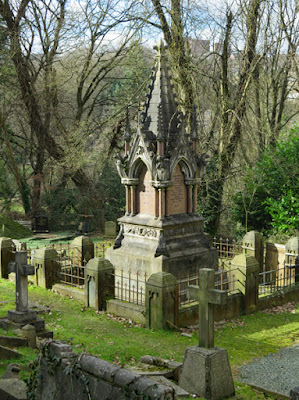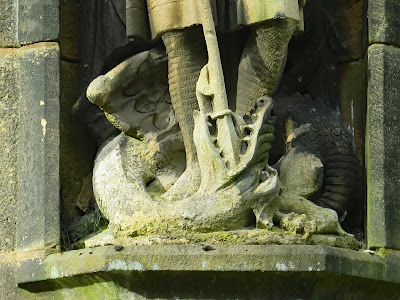 |
| The monument to the Foster family |
When planning my day out to explore the geology and historic buildings of Crookes, I had originally intended to also explore Walkley, principally to have a look at the Sheffield Board School at Bole Hill Road by WJ Hale and another at Burnaby Crescent by Innocent and Brown – architects that I had never heard of before.
Standing on the highest point of Bolehills, however, where I was looking down at the 15 storey tower blocks in Stannington on the other side of the Rivelin Valley, I realised that I had made a great mistake in the planning of my walk.
Making my way down to the Rivelin Valley through an area where the Crawshaw Sandstone was once extensively quarried, I came across a steep path to St. Michael’s Catholic Cemetery, which was my next planned stop.
After giving my best regards to a young woman who was running up the path, I mumbled to myself - “I am not going back up that chuffing hill” - and decided that I would explore Walkley another day.
Arriving to find that a funeral was about to take place at the cemetery, I just discreetly wandered around the cemetery to photograph the Grade II Listed chapel by Charles Hadfield – of the family architectural practice that had designed St. Joseph’s church in Handsworth – and a couple of the large monuments that are also listed.
I didn’t examine the building stones here, but the Historic England listing states that these are Greenmoor Rock for the walling, with a coarser sandstone used for the quoins and dressings, which was quarried at Worrall from the Loxley Edge Rock – another sandstone used for very many historic buildings in Sheffield.
Although a few of the sandstone blocks surrounding the statue of St. Michael have a green/grey colour typically associated with the Greenmoor Rock, this formation is best known for producing for paving stones and memorials and the walling stone is generally thin bedded – a characteristic that is not seen in the masonry here.
On this occasion, I was more interested in the pale cream coloured stone used for the statue of St. Michael, which is a Jurassic oolitic limestone. The same architectural practice designed Crookes Cemetery chapel, dated 1908, where Bath stone from the Monk’s Park mine in Corsham, Wiltshire, has been used for dressings, in preference to the Ancaster stone from Lincolnshire that is normally used in this region.
A few metres to the west of the chapel, the striking monument to GH Foster and family provides an example of pink Peterhead granite from Aberdeenshire in Scotland, which was used widely by Victorian architects and memorial masons – often in combination with the grey Rubislaw granite.
The white stone used in its plinth and for the ornate gables, pinnacles and angels, however, is not Portland stone – as also stated in the Historic England description – but is white Carrara marble from the Apuan Alps in Italy.
From a distance, these materials look very similar and it is very easy to make this mistake, especially when dirty but, if able to get close enough to touch the stone, the marble has a uniform saccharoidal texture – formed by the chemical weathering of the interlocking calcite crystals – whereas the weathered surface of Portland stone typically has exposed angular fragments or even thin beds of fossil oysters and other shellfish.
On this occasion, the iron railings prevented me from being able to get near enough to touch the stone, but I was nonetheless able to observe its texture and - although the loss of fine detail confirmed that the surface was weathered - there were no signs of any fossils. structures.












No comments:
Post a Comment